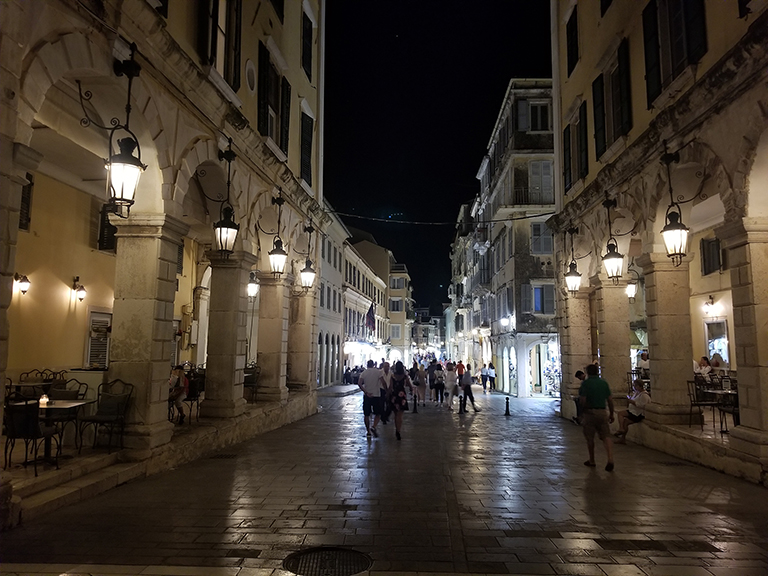
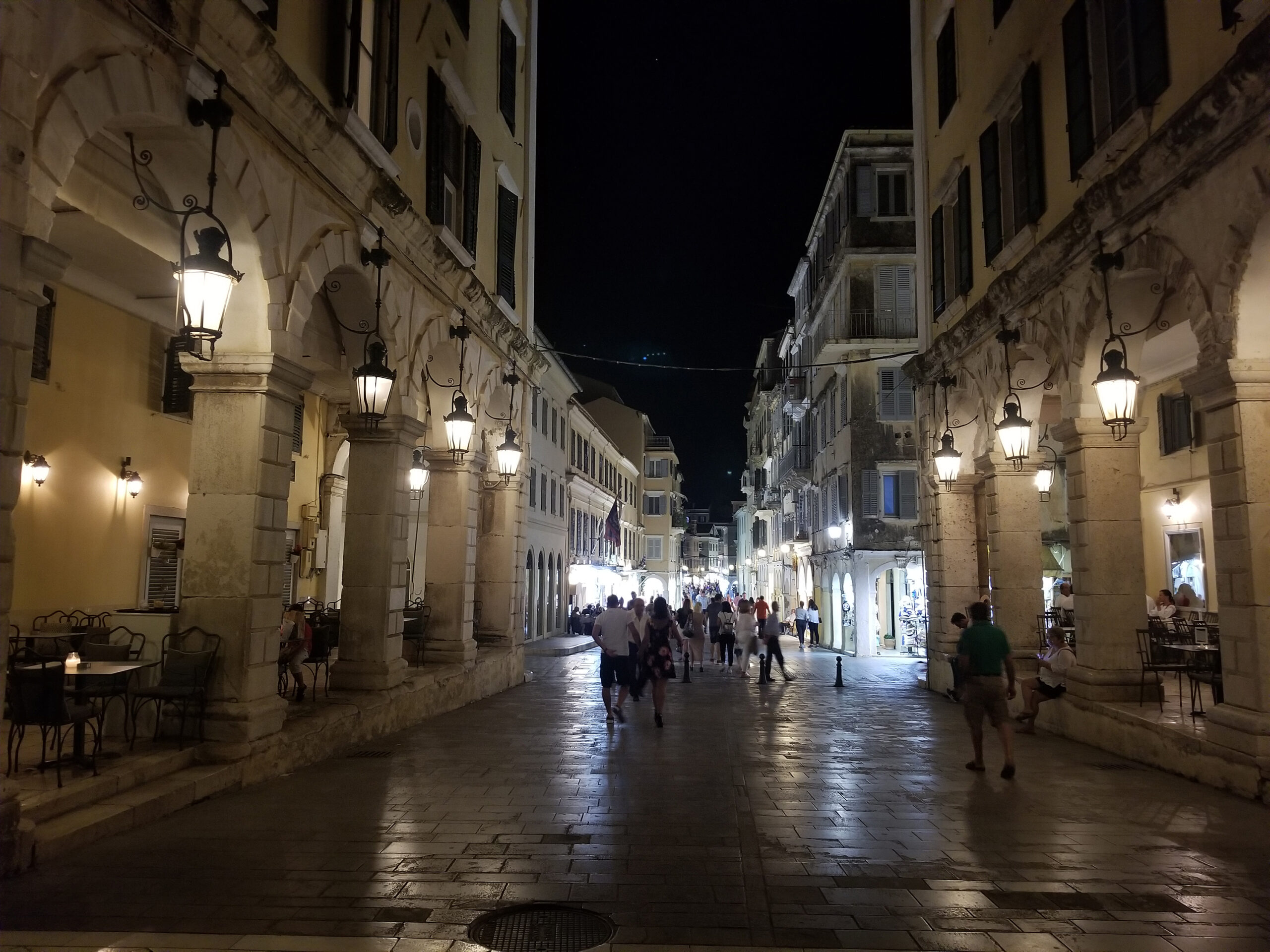

The last day should be reserved for the capital of the island, which has the same name as the island, Korkyra or in our language Corfu. What we see of the city today are the remains of the medieval city from the period of Venetian rule.

The ancient city was located slightly south of today’s central city core, above the airport. In the historical period, Strabo mentions that Korkyra was inhabited by the Illyrian tribe Liburnians until 735 BC when they were forced to leave the island under pressure from the greek polis Corinth. In that period, the Corinthians were the first to settle the island, and the Corinthian tyrant Periander handed it over to his son Lycophron. The local population organized a rebellion against Lycophron, whom they then killed. Perijandar sent a punitive expedition, which captured 300 local inhabitants and sent them into captivity. This is how ancient Korkyra managed to become an independent city-state – polis.

Several important buildings have been preserved at the Palaiopolis archaeological site. Of the temples, the most preserved was the Kardaki temple.

Here you can see a massive Doric column. It consists of a trunk that is furrowed with a vertical groove, on top of which there is a capital.
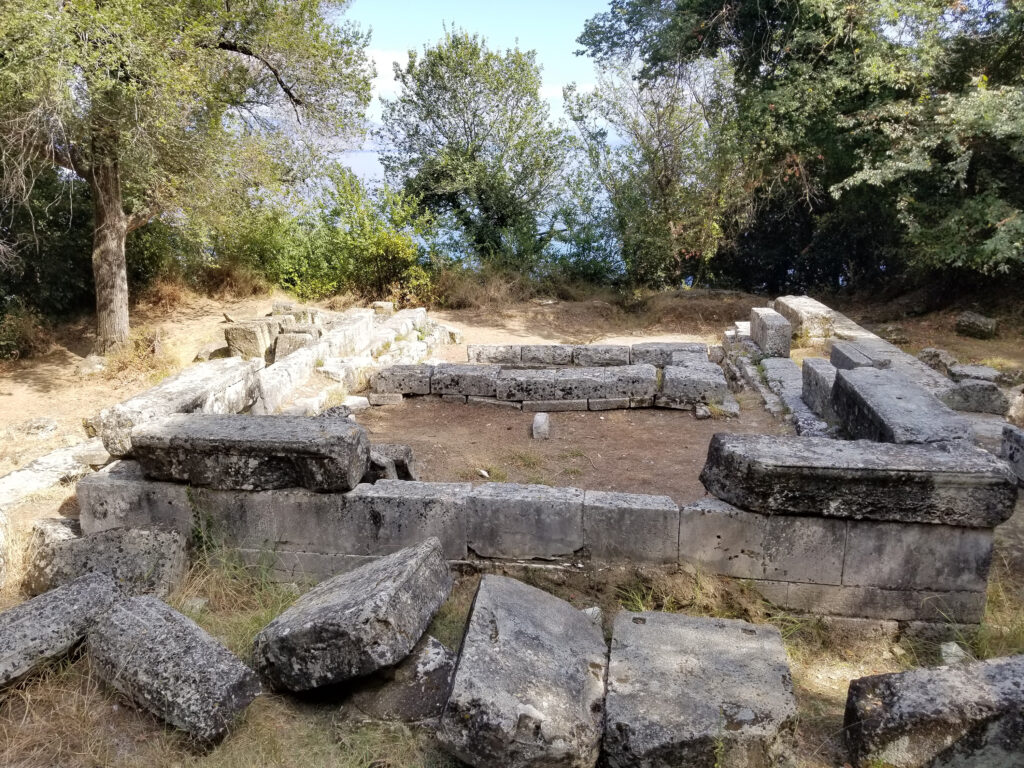
The ancient Greeks believed that their gods resided in temples, which is why the faithful never entered the temple but attended the worship service in front of the temple. The main part of the temple is called naos or cella and it housed the statue of the deity to whom the temple was dedicated. As for Kardaki temple, it is not known exactly to which god he was dedicated.

The Temple of Artemis is the most important temple on the island, although the site itself is not well preserved. The Temple of Artemis in the history of architecture is the oldest example of a Doric temple.
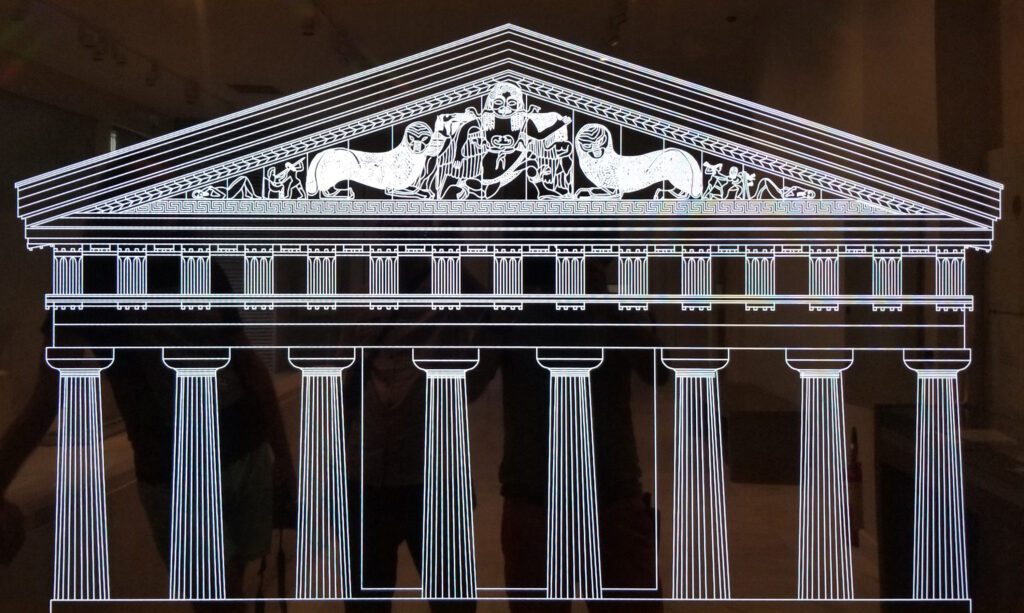
A drawing of the reconstruction of the temple can be seen in the city’s archaeological museum. In addition to the columns and the nave, the most prominent part of the temple is the triangular gable, which stands above the columns. Reliefs and sculptures were placed in the gables.
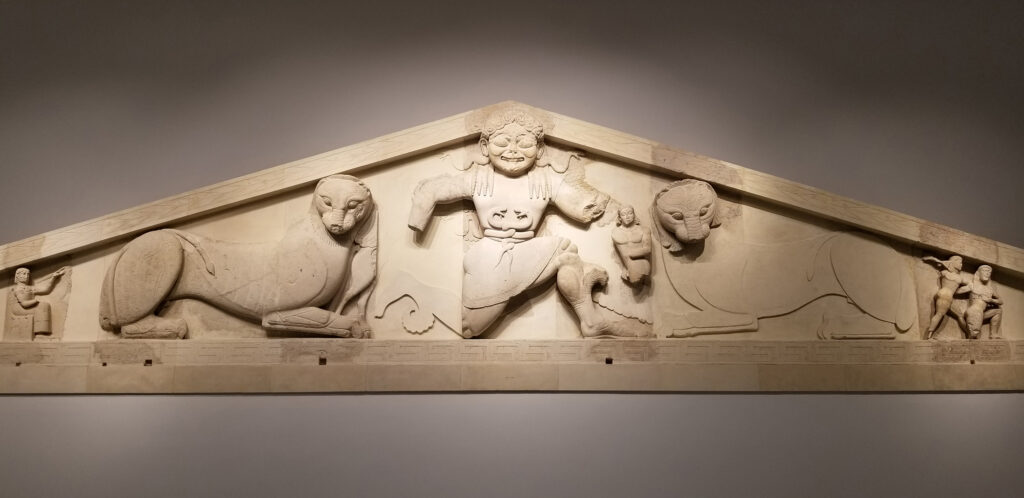
The pediment of the Temple of Artemis, in which there is a sculpture of Medusa, is preserved in the archaeological museum. Medusa was one of the three Gorgons, monstrous beings with a woman’s head and snakes coming out of her hair. They had boar-like teeth in their mouths, a long tongue, and they also had wings. If they looked at someone with their staring eyes, they would turn to stone in an instant. The ancient hero Perseus cut off the head of Medusa, after which her sons came out of the head, the winged horse Pegasus (who is shown on the left of Medusa – only the back and part of the wings are visible) and Chrysaor – a man with a golden sword (shown to the right of Jellyfish). To the left of Pegasus and to the right of Chrysaor are two lions. All the way to the left and right on the pediment is depicted the titanomachy, that is, the war between the Titans and the Olympian gods, led by Zeus. The war between the gods began when Zeus rebelled against his father, the titan Chron, from which Zeus emerged victorious, enthroning himself as the supreme god.
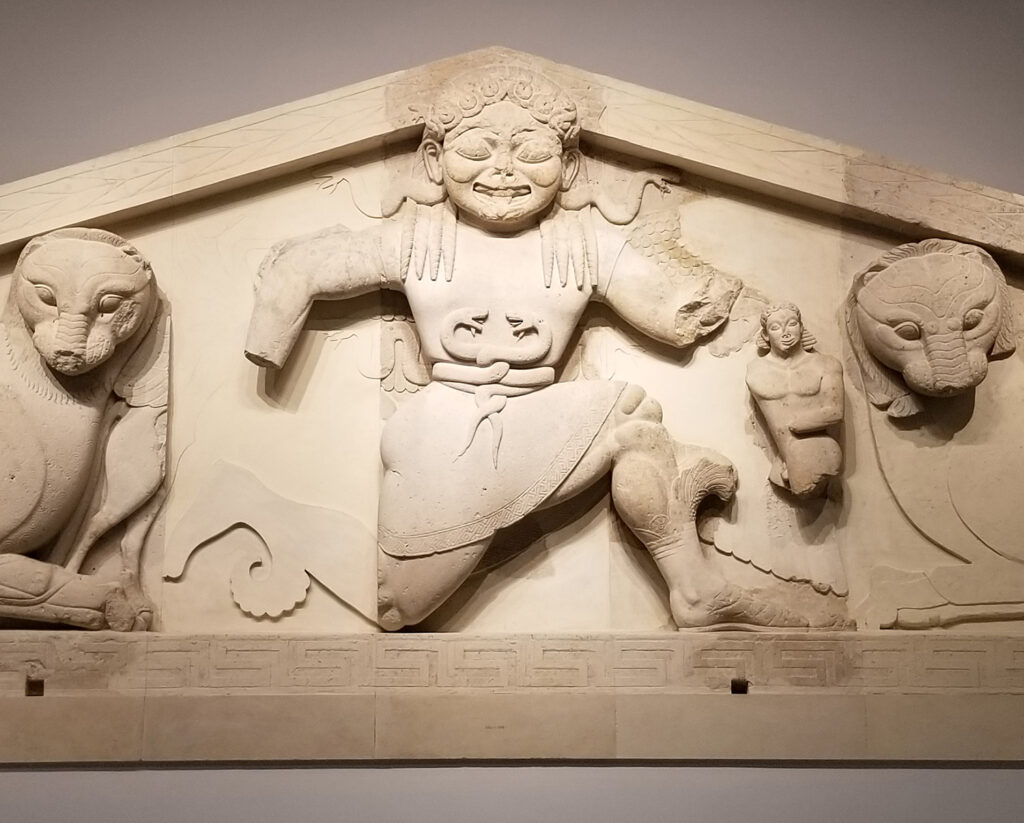
The question arose as to why Medusa, and not Artemis, was depicted in the temple of Artemis. The purpose of Medusa together with the lions is to protect Artemis, whose sculpture was located in the central part of the temple. Medusa is depicted as a walleyed witch, smiling at us and flying towards us. Lions were used as guards before, for example in the Mycenaean civilization, of which the Lion Gate in Mycenae has been preserved.
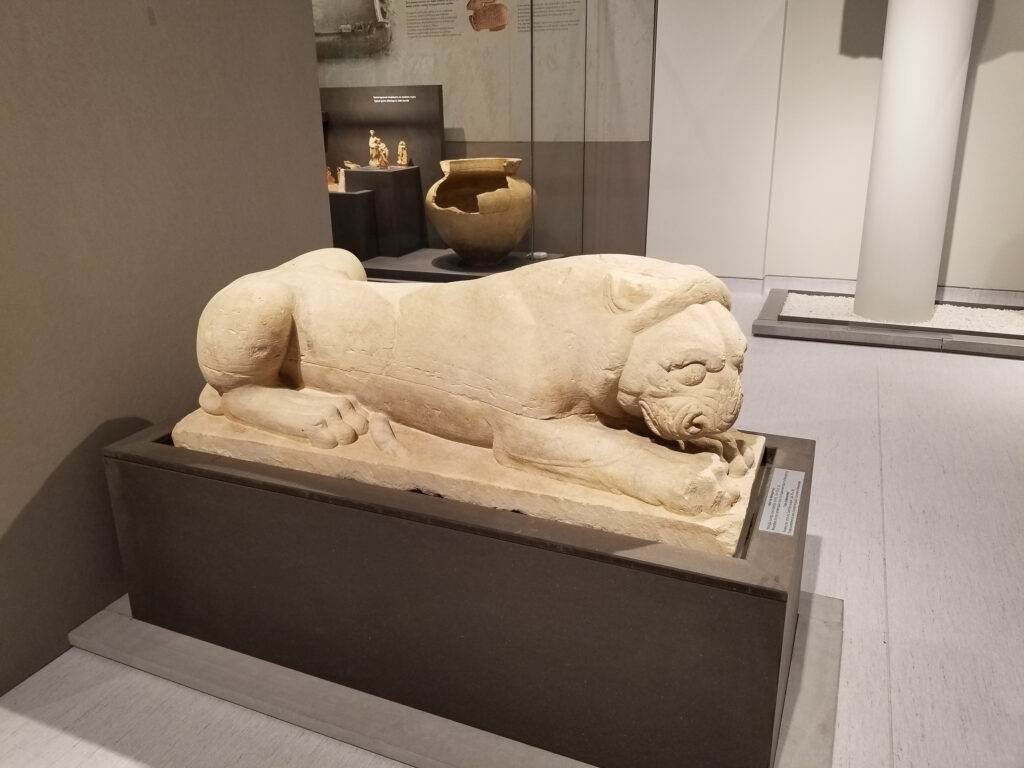
There is an even older sculpture of a lion in the museum, which dates back to the 7th century BC.

Sculpture of lion was found on the tomb of Menekrates, the ambassador of Kerkyra, who tragically perished at sea. His body was never found, but that’s why a tomb and a monument were built in his honor.

Remains of an early Christian basilica from the 5th century were found on Corfu. Even in the Roman period, pagan basilicas were built, which had primarily a secular, not a religious, character and were used for various civic gatherings, and were often the seat of the court. When Christians received the right to freely profess their faith with the Edict of Milan, they used basilicas as a model for building churches in the period from the 4th to the 7th century. Early Christian basilicas were rectangular in shape with 3 or 5 naves, of which the main nave ended with a semicircular apse in which the altar was located. The main nave was cut by a cross nave – the transept, which gives early Christian basilicas a cross-shaped form. Later, the Romanesque and Gothic churches of Western Europe will take the form of early Christian basilicas.

In the early Christian basilica in Corfu, floor and wall mosaics were found.
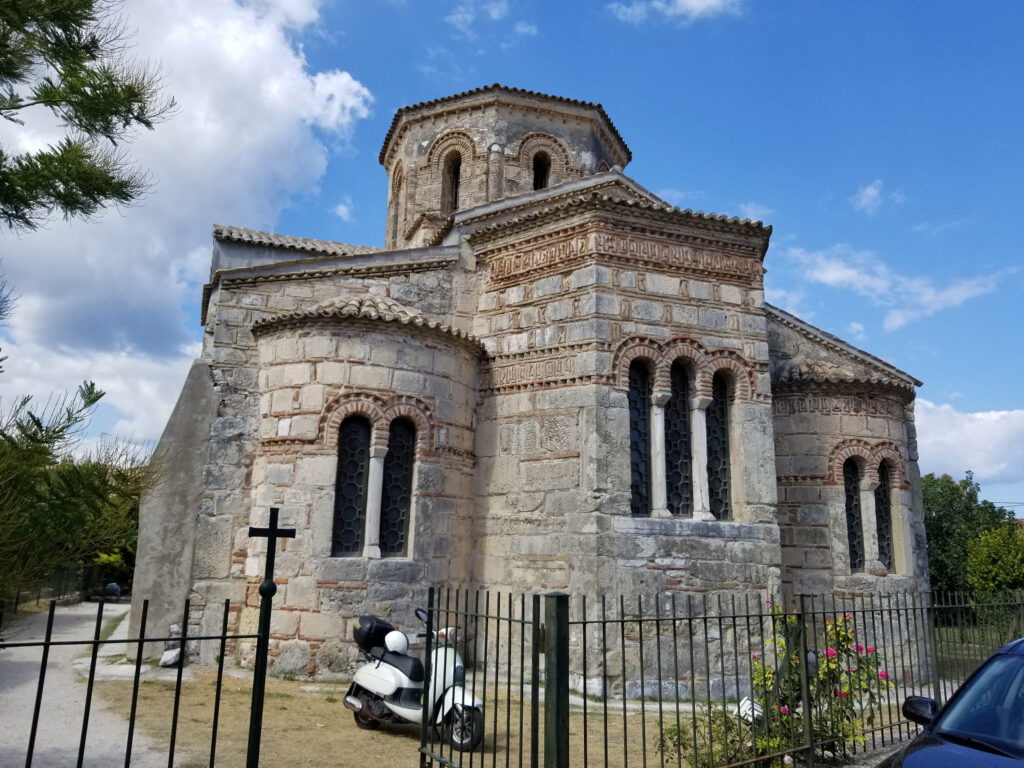
Near the early Christian basilica, there is a slightly younger church of Saints Jason and Sosipater, built in the Byzantine style in the XI century. Unlike the basilica, the Byzantine type of church has a square base with a Greek cross (both arms of the cross are of equal length) in the middle above which rises a dome. In the Byzantine style, the dome stands on a roller base – a tambour, which consists of windows. The windows on the walls can be bifores and trifores. In bifor, the window opening consists of two, and in trifor, three windows separated by columns.

The interior of the church was done in the Baroque style from the 18th century. The church was dedicated to Saints Jason and Sosipater, disciples of the Apostle Paul, who spread Christianity in Corfu.

The statue of the Italian artist Antonio Corradini in the spacious square of Spianada, erected around 1720, represents the Prussian general Matthias von Schulenburg, who was hired by Venice and appointed as commander of the defence of the fortress on Corfu in 1716.

This relief shows a winged lion with an open book of the Gospels, which is the official coat of arms of the Republic of Venice. The lion symbolizes the evangelist Mark, who was the patron of Venice. When the book is open, it means that the building with the relief was built in a time of peace, and the reliefs in which a lion holds a closed book means that the building was built in a time of war. There are other interpretations of open and closed book.

The central city core, exudes the Venetian spirit. The buildings were built in streets, made at right angles, with narrow alleys and colonnades in which various colors are mixed – ocher, red, yellow, etc. But what we see today are reconstructed buildings, because during World War II, the city was heavily damaged by German bombing. The Italians initially occupied Corfu in 1941, but after the capitulation of Italy in 1943, the Germans, before landing on the island, carried out a terrible bombardment of the city on September 14, 1943.

The huge buildings are the magnificent baroque palaces of former Venetian aristocrats.

The square with the well is reminiscent of Venetian squares.

One of the remains of Venetian architecture is the bell tower of the Church of the Annunciation, built by the Venetians in the 14th century. The church no longer exists today, because it was demolished after the German bombing of the city.
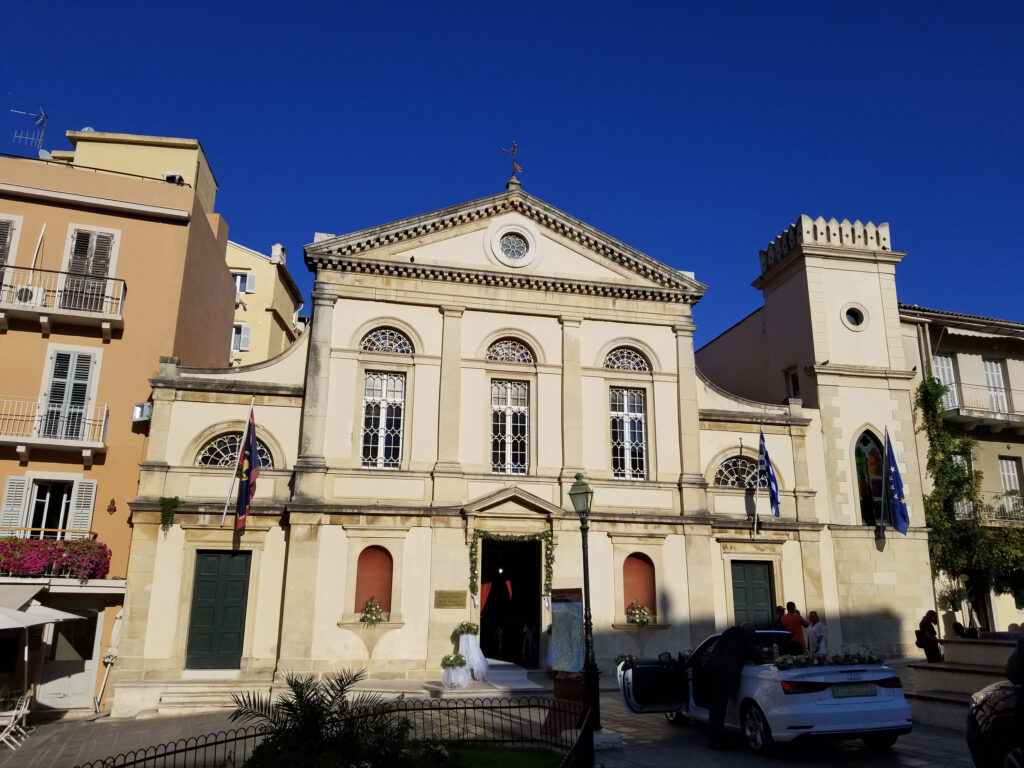
The Catholic baroque Cathedral of Saint James and Saint Christopher, which represents the seat of the archdiocese for the Ionian Islands, also originates from the Venetian period. Like Annunziata, it was heavily damaged during the German bombing, but was rebuilt after the war.

The San Giacomo Venetian Opera House was built in the 17th century and originally served as a gathering place for the Venetian aristocracy. It operated as an opera from 1733-1898. year, so that today it serves as the building of the town hall.

The sculpture on the facade of the town hall represents the Venetian aristocrat Francesco Morosini, who was the Doge of Venice during the wars against the Turks. Before being elected Doge, Morosini served as a general in the Canadian War against the Turks. On the sculpture, Morosini is surrounded by four children, symbolizing his four victories in wars against the Turks. The Morosini family was a prominent Venetian aristocratic family, dating back to the Middle Ages, which gave Venice a large number of doge, generals, admirals and cardinals.

Statue of Ioannis Kapodistrias, the first president of Greece, who was born in Corfu. In 1821, an uprising against Turkish rule broke out in the Peloponnese, and in 1822, Greece’s independence was proclaimed. However, there was no harmony among the insurgents, and at one point there was even a civil war. Kapodistrias was elected president of Greece in 1827. Before that, Kapodistrias was the Minister of Foreign Affairs of the Russian Empire and a highly respected diplomat. Although he achieved a lot of success during his service, he incurred the wrath of the Greek elite, made many enemies, and was assassinated in 1832. Those conflicts were between the traditional Greek elites and the modernizers – those Greek politicians who were educated and lived in the West. Those modernizers looked down on the traditionalists. During the 19th and 20th centuries, Greece had a long tradition of political conflicts, dictatorship and civil wars, which began during the war for independence, and culminated in the civil war from 1946-1949. years.

After the downfall of Napoleon and the Congress of Vienna in 1815, Corfu and the other Ionian islands fell under the authority of the British Empire, which ruled the islands until 1865, when they were annexed to Greece. There are several buildings that bear witness to the British colonial rule on the island, the most famous of which is the City Palace, which was built by the British and served as the residence of the British Governor of the Ionian Islands.

Monument to Thomas Maitland, the British governor of the Ionian Islands, who ordered the construction of the palace.
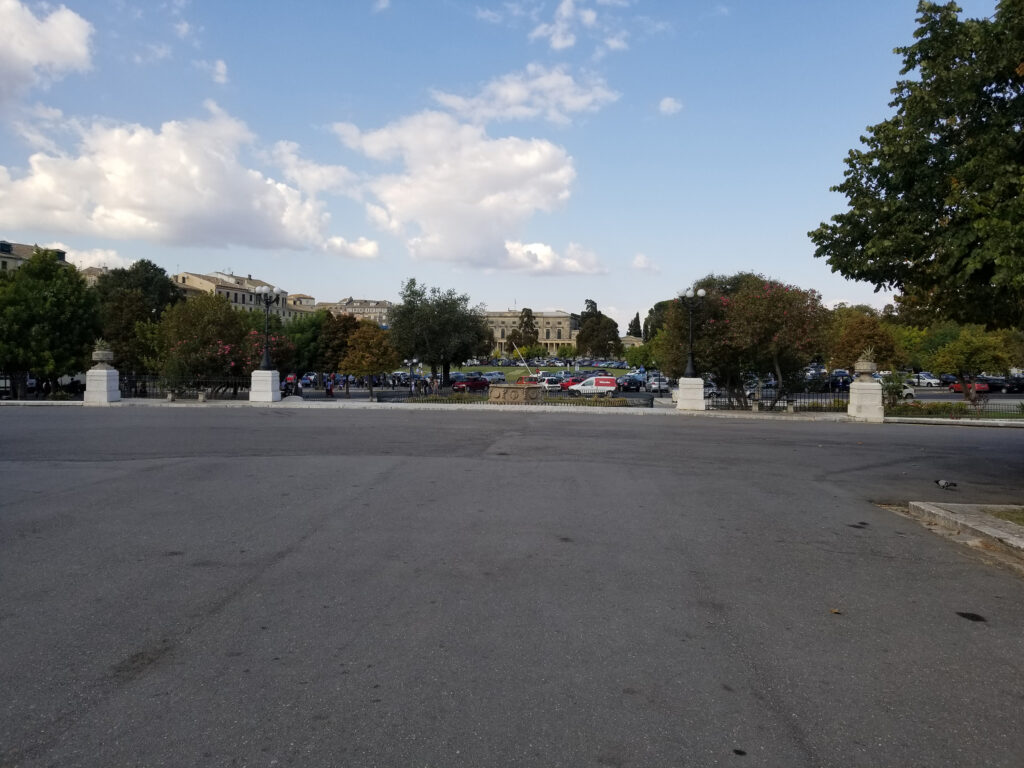
Spianada is a spacious city square, the largest in Greece.

The tradition of playing cricket in this spacious square, which dates back to the time of British rule, has been preserved to this day.

When the British left, they left behind roads, water supply and perhaps the most important invention, houses with toilets, which was unimaginable for Greece until then. On the island, residential buildings with toilets and bathrooms were called “English House”. Until then, there was no culture of body cleanliness in Greece, it was believed that people bathed only when they needed something for medical reasons.

And finally we come to the church of Saint Spyridon, a more important building for the local Greeks and the people of Corfu. The church was built in the 16th century and is completely done in the Baroque style, as the Venetians used to build their Catholic churches. The bell tower of the church is very similar to the bell tower of the church of St. Mark in Venice.

The interior of the church is also done in the Baroque style, but the iconostasis tells us that it is an Orthodox church. Behind the iconostasis are kept the relics of Saint Spyridon wearing slippers. Saint Spyridon is the patron saint of the island and the largest number of men today bear his name.
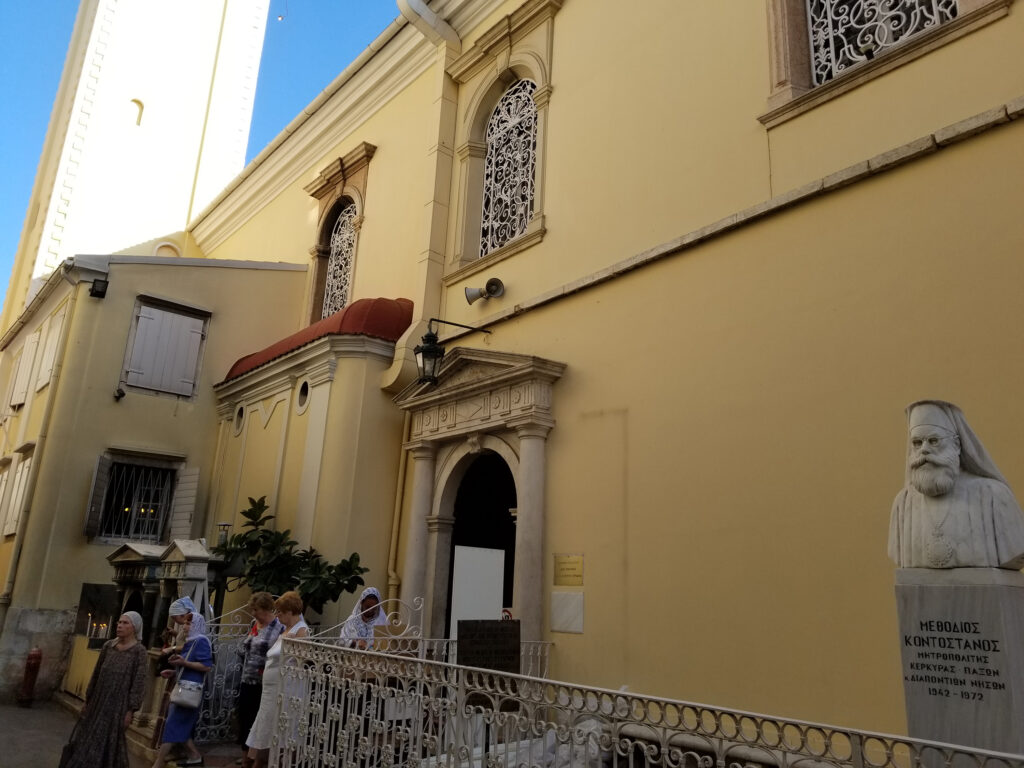
St. Spyridon was originally from Cyprus where he was originally buried. Before the Saracens captured Cyprus, his remains were transferred to Constantinople. Before the fall of Constantinople to the Turks, a monk, who at the same time was a rich merchant, Kalohairetis, brought the relics of St. Spyridon and St. Theodora, the Byzantine empress, was transported on a mule from Constantinople first to Epirus, and then to Corfu. The relics of these saints were his property, which were passed on to his sons. The two older sons divided the relics of the saint into two parts, while the younger son inherited the relics of Empress Theodora. One of Kalohairetis’s grandsons, Philip, united the saint’s two halves again and unsuccessfully tried to smuggle them to Venice, where he could sell them for a lot of money. Philip’s daughter brought the relics to the Vulgari family, so that in 1580 they were buried in today’s church. Since, according to popular belief, the saint defended the island from the Turkish invasion in 1537, he became very popular among the population. It was also believed that the saint saved the island from a plague epidemic in the 17th century. In addition, he was the patron saint of sailors and fishermen. Four times a year, processions are organized in the city, when the saint’s relics are taken out of the church. In the procession of the saint, six sailors are carried in a closed litter over which stands a canopy. With St. Spyridon, we end a ten-day trip around Corfu.
More information about Old Fortress in Corfu Town you can see on article Medieval Castles.
Check other Corfu’s Wonders Corfu Beaches, Myths and Legends, The Achilleion Palace and Mount Pantokrator.
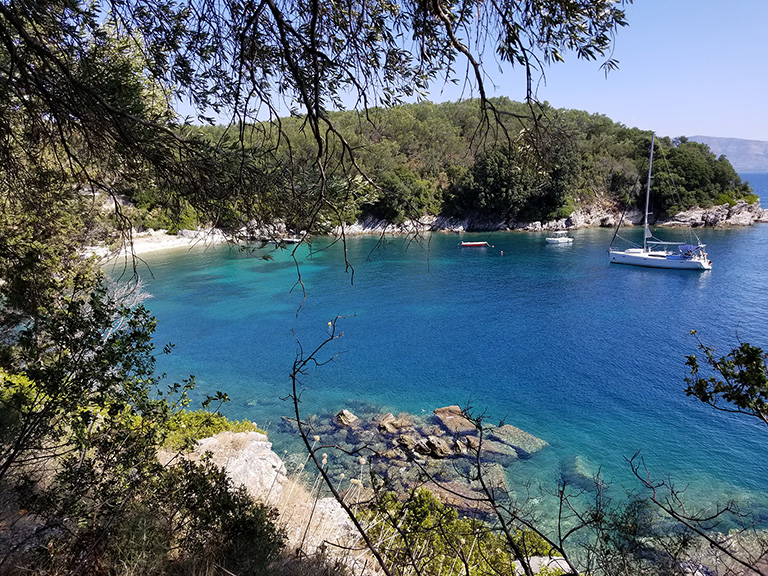
Corfu is popular tourist destination since 19th century. Discover Cape Drastis that was admired by Lord Byron or White House whi
Read More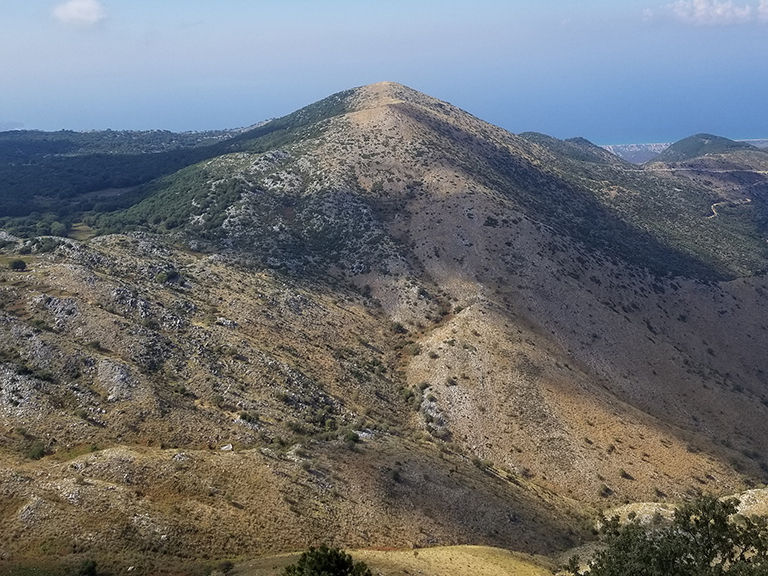
Corfu was the island on which many ancient Greek myths and legend took place. According to the Greek mythology first inhabitants
Read More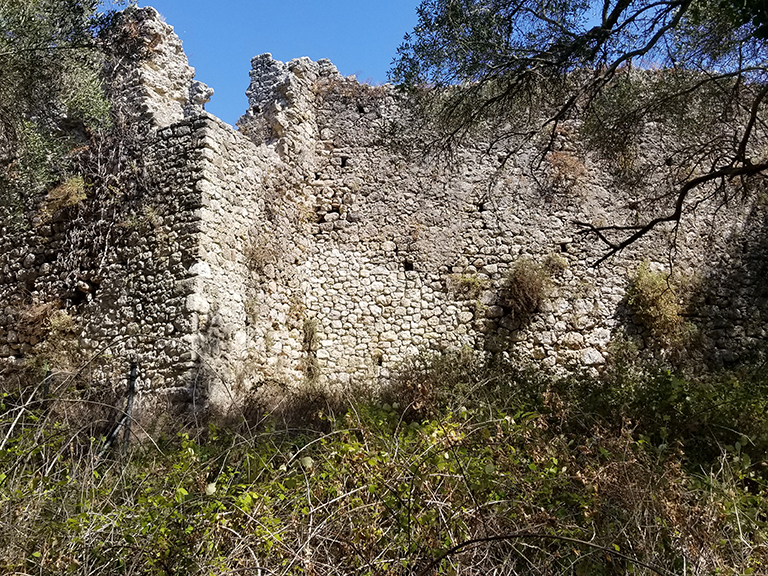
In this article you will find out more information about medieval castles built by Byzantines and Venetians during Middle Ages a
Read More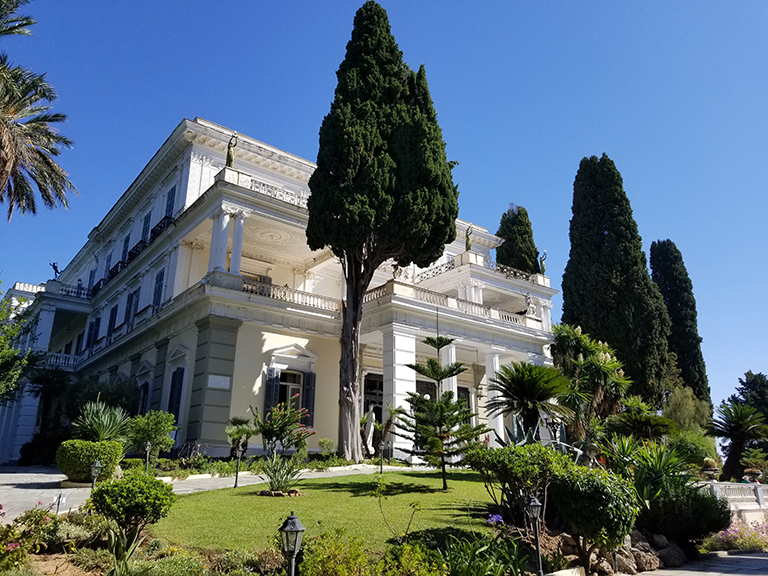
Achilleion is located at a village of Gasturi, ten kilometres south of the city of Corfu. Built on the top of the hill it prov
Read More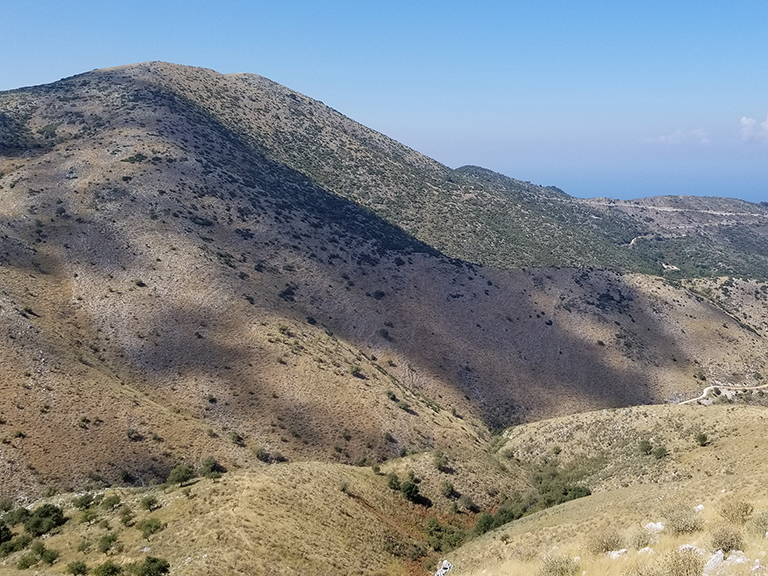
Mount Pantokrator with height 906 metres (2,972 ft) is the highest mountain on the Corfu island. From the summit you can see ent
Read More